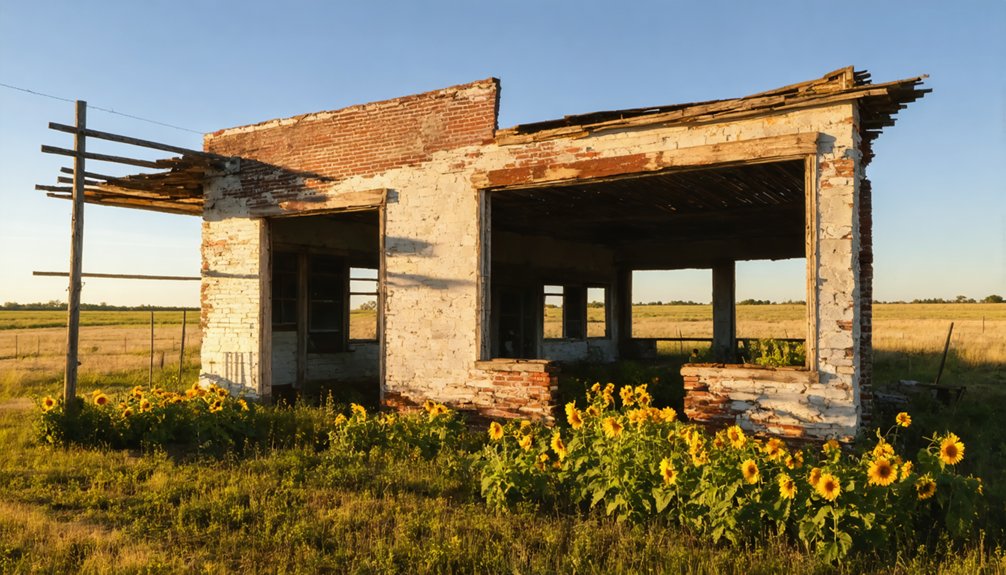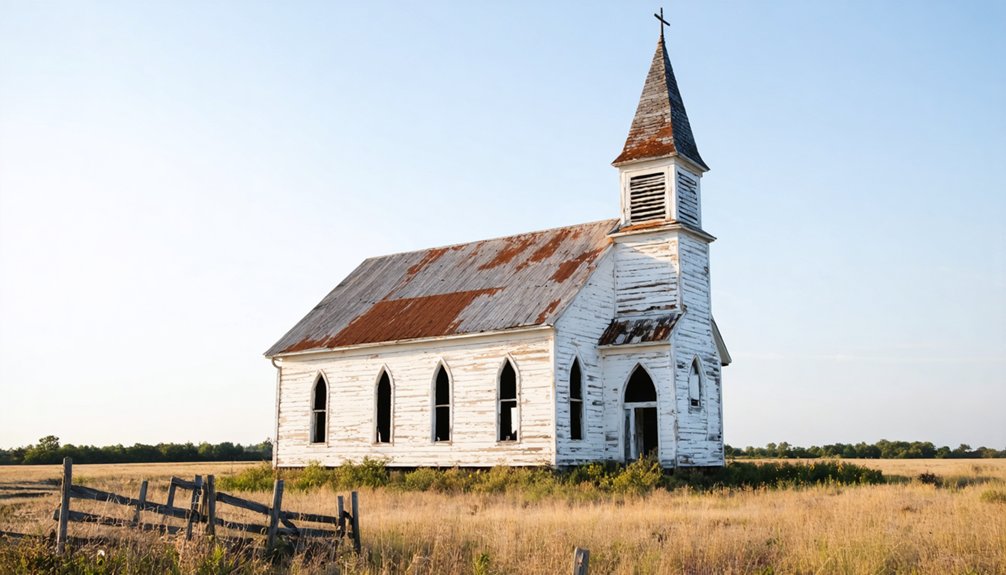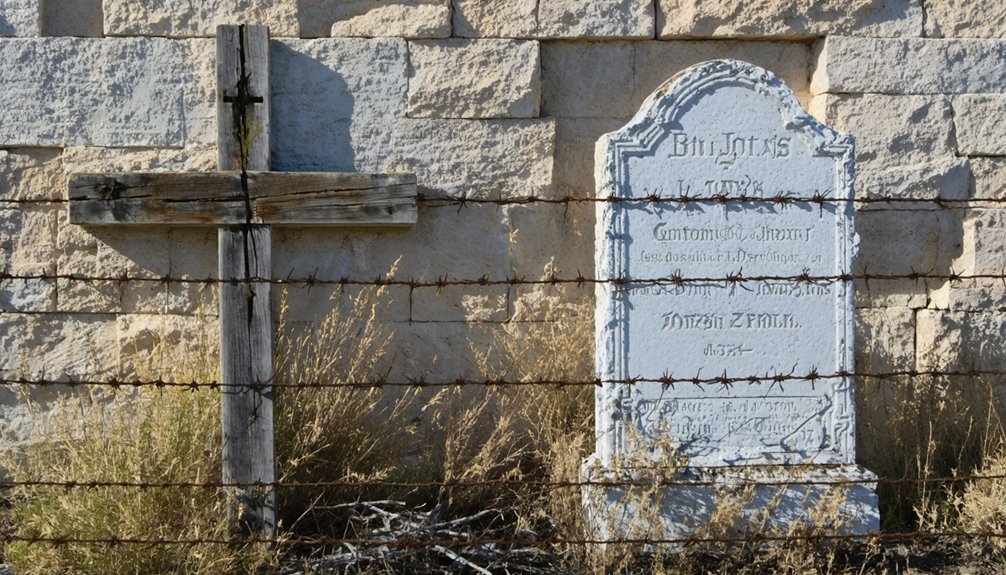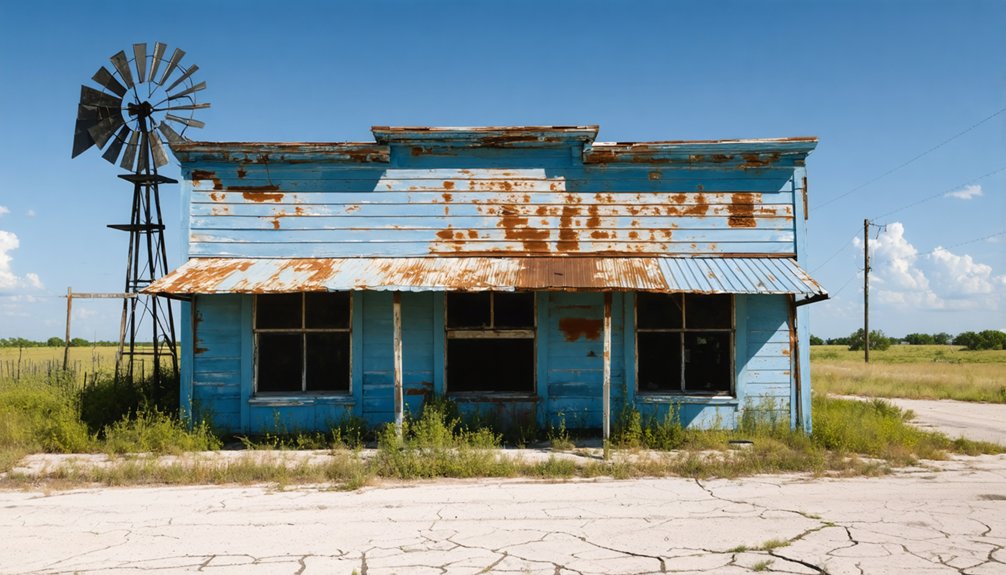You’ll find the ghost town of Pisek near the Fayette and Austin County lines in Texas, where Czech and German immigrants first settled as Lone Oak. After the Missouri, Kansas and Texas Railway arrived in 1887, the town relocated and thrived with a post office, saloon, cottonseed warehouse, and general stores. When the railroad extended to Houston, Pisek’s importance as a shipping hub faded. The remnants tell a rich story of Czech heritage and frontier life.
Key Takeaways
- Pisek transitioned from a thriving Czech-German settlement to decline after the railroad extended to Houston, reducing its importance as a shipping hub.
- Originally named Lone Oak, the community relocated and became Pisek in 1887 when the Missouri, Kansas and Texas Railway arrived.
- The town’s economy centered on cotton production and railroad shipping, but both industries declined significantly by mid-20th century.
- Key structures included a post office, saloon, cottonseed warehouse, and general stores, which have largely disappeared over time.
- Located near Fayette and Austin County lines, Pisek’s remaining features include scattered buildings and its cultural Czech heritage.
From Lone Oak to Railway Settlement
Before the railway’s arrival transformed the region, the small farming community of Lone Oak served as the area’s original settlement, taking its name from a distinctive oak tree situated near a significant crossroads three miles north of what would become Pisek.
The Lone Oak history reflects the area’s early demographics, with Czech and German immigrants establishing a modest but self-sufficient community. Similar to the Czech city founded in 1254, the settlers created a royal free town atmosphere. You’ll find that these settlers maintained essential services, including a post office and blacksmith shop, while focusing primarily on agricultural pursuits. A vital shipping point emerged as the community developed a cottonseed warehouse to support local agriculture.
When the Missouri, Kansas and Texas Railway arrived in 1887, you’d have witnessed a dramatic shift as the community relocated about a mile from their original site to be closer to the railhead. The settlers rejected the railroad’s proposed name of Sandy Point, instead choosing Pisek to honor their Czech heritage.
Czech Heritage and Cultural Roots
The Czech immigrants who settled Pisek left an enduring cultural imprint that shaped the town’s identity well beyond its railway beginnings. As part of Fayette County‘s “Cradle of Czech Immigration,” Pisek’s settlers maintained strong ties to their homeland through language, customs, and traditions they brought from the Austro-Hungarian Empire. With Fayette County being home to the largest Czech population per capita in Texas, the area became a crucial hub for Czech heritage preservation. Two stores and blacksmith operations marked the town’s early commercial development.
You’ll find their legacy preserved today through cultural preservation efforts of organizations like the Czech Heritage Society of Texas and the Texas Czech Heritage and Cultural Center in La Grange.
These institutions safeguard everything from genealogical records to traditional folk music and dance. Czech festivals throughout the region still celebrate the authentic cuisine, including kolaches and klobása, while traditional polka music and kroj costumes remind visitors of the deep cultural roots these immigrants established in Central Texas.
Life Along the Katy Railroad
While Pisek’s early growth centered on farming, it was the arrival of the Missouri-Kansas-Texas Railroad that transformed this rural settlement into a bustling transportation hub.
You’d find the Katy Railroad’s influence woven throughout daily life, as the depot became the heart of community activity and commerce. The railroad’s presence attracted new settlers and businesses, linking Pisek to larger markets across Texas and beyond.
Like many small towns along the Katy’s route, you could witness the exchange of agricultural goods and livestock, connecting local farmers to distant markets. Operating primarily on light rail tracks, the Katy faced limitations in its freight capacity throughout its network. By 1904, the railroad had grown to operate 1,119 miles of track across Texas.
The depot served as more than just a shipping point – it was a social center where families gathered and news traveled.
Though passenger service ended in the mid-1950s, the Katy’s community impact continued through freight operations until its merger with Union Pacific in 1988.
Agricultural Legacy and Local Economy
You’ll find Pisek’s agricultural story deeply intertwined with cotton production, as evidenced by its prominent cottonseed warehouses and position along the historic “Cotton Road” trade route.
During the late 19th century, the Missouri, Kansas and Texas Railway’s extension in 1887 transformed Pisek into a bustling agricultural shipping hub, with rail facilities supporting the transport of cotton and livestock to broader markets. Like many communities in Colorado County, Pisek’s development was heavily influenced by railroad expansion and land promotions.
The town’s economic significance hinged on this combination of cotton farming and railroad access, though both would eventually decline by the mid-20th century, leading to Pisek’s abandonment. Most residents maintained small gardens and livestock, which provided sustenance rather than commercial farming opportunities.
Cotton Farming Operations
Beginning as a modest agricultural venture in 1821, cotton cultivation transformed Central Texas into a thriving agricultural powerhouse through the efforts of Anglo-American colonists who drew from their Deep South farming experience.
You’d find the most productive farms along the fertile Brazos and Colorado river bottoms, where cotton production flourished despite initial land grants favoring ranching.
Under the widespread crop-lien system, tenant farmers often found themselves trapped in perpetual debt by purchasing supplies from landowner-operated commissaries.
By 1920, fifty-five percent of Bastrop County’s farms were operated by tenant farmers, highlighting the dominance of this agricultural arrangement.
Railroad Shipping Hub
The Missouri, Kansas and Texas Railway’s construction of a turntable in 1887 established Pisek as an essential railroad shipping hub, attracting Czech and German settlers to the area.
This railroad innovation transformed the local economy and revolutionized transportation efficiency across Texas.
You’ll find Pisek’s significance as a shipping center highlighted by these key developments:
- A strategic turntable allowed trains to reverse direction, streamlining goods movement
- The establishment of crucial commerce points including a post office, saloon, and cottonseed warehouse
- The community’s emergence as a major agricultural shipping point by 1896
As a critical railhead, Pisek connected local farmers to broader markets, enabling unrestricted trade and economic growth.
The community thrived until the railroad’s extension to Houston redirected traffic patterns, ultimately leading to its decline.
The Rise and Fall of a Texas Town

During the 1880s, Pisek emerged as a small but promising Texas settlement, strategically positioned along Farm to Market Road 1291 near the Fayette and Austin County lines.
You’ll find that town dynamics centered around Czech and German settlers who established two initial businesses, creating vibrant cultural exchanges in this frontier community.
The arrival of the Missouri, Kansas and Texas Railway in 1887 transformed Pisek into a bustling railhead.
You’d have seen a thriving community with a post office, saloon, cottonseed warehouse, and general stores.
However, when the railroad extended to Houston, Pisek’s importance as a shipping hub diminished. Residents gradually moved back to the original settlement area, now known as Lone Oak.
Daily Life in Early Pisek
Life in early Pisek revolved around a tight-knit community of Czech and German immigrants who shaped their frontier settlement through agricultural pursuits and railroad-dependent commerce.
Your daily routines would’ve centered around these key activities:
- Working the surrounding farmlands and processing cotton at the local warehouse.
- Trading goods at small retail stores that served as community gathering spots.
- Socializing at the saloon where you’d connect with neighbors after a long day’s work.
You’d find yourself depending heavily on the Missouri, Kansas and Texas Railway for shipping your agricultural products and receiving supplies.
The post office served as your essential link to the outside world, while the sandy soil beneath your feet reminded you of the rugged Texas terrain you called home.
Architecture and Historic Structures

While reflecting the resourcefulness of its Czech and German settlers, Pisek’s architectural landscape prominently featured adobe and wooden structures topped with tin roofs, adapting central European building traditions to the Texas frontier.
You’ll find the town’s construction materials tell a story of practical innovation, with locally sourced adobe providing natural insulation against Texas weather extremes.
Commercial buildings showcased simple yet functional architectural styles, strategically positioned along FM 1291 near the railroad for efficient trade. The railway’s influence dominated the town’s layout, centered around a turntable building and related infrastructure.
Distinctive features like cupolas adorned some structures, while others expanded through various additions marked by changing rooflines. The cottonseed warehouse and saloon exemplified the straightforward, purpose-driven design that characterized Pisek’s building approach.
Natural Landscape and Geography
You’ll find Pisek situated at 291 feet above sea level among the gently rolling plains of northern Colorado County, Texas.
The town’s natural landscape features Boggy Creek, which meanders through the former settlement before joining the larger Cummins Creek system.
The surrounding terrain’s mix of grasslands and scattered hardwoods, combined with the area’s natural drainage patterns, created conditions that once supported small-scale agriculture and early settlement.
Elevation and Terrain Features
Located in the heart of Colorado County, Pisek sits at a modest elevation of approximately 290 feet above sea level, making it considerably lower than Texas’s average elevation of 1,700 feet.
You’ll find minimal elevation changes across the landscape, characteristic of the coastal plains region. The terrain variations are subtle yet distinct, creating an open vista that stretches across the countryside.
The area’s notable features include:
- Flat to gently sloping agricultural fields with productive soil conditions
- Native vegetation interspersed with open spaces and rural infrastructure
- A mix of grasslands and scattered wooded areas typical of the Gulf Coastal Plain
This ghost town’s terrain reflects its agricultural heritage, with land that’s still suitable for farming and ranching activities despite its abandoned status.
Creeks and Water Systems
As Boggy Creek winds through the former settlement of Pisek, it serves as the primary waterway in a complex network of streams that shape the local landscape.
You’ll find this creek eventually joins Cummins Creek, creating essential connections within Colorado County‘s northern watershed. The area’s gentle topography supports multiple tributaries that feed these main waterways, influencing water quality and supporting diverse riparian ecosystems.
These creeks haven’t just shaped the physical terrain – they’ve historically defined settlement patterns and transportation routes.
You can trace their influence in the placement of Fischer-Buller Road and FM 1291, while their seasonal flows continue to affect local drainage and soil composition.
The watershed’s health remains significant, impacting ecosystem services and drainage patterns throughout the broader Colorado County basin.
Agricultural Soil Characteristics
The agricultural soils of Pisek reflect the complex interplay between its waterways and geological history. You’ll find deep, well-drained clay loams and sandy loams dominating the area, with soil composition varying between the uplands and bottomlands near Boggy and Cummins Creeks.
For successful fertility management in Pisek’s soils, you’ll need to evaluate these key characteristics:
- Neutral to alkaline pH levels in upland areas, ranging from 7.0 to 8.5
- Higher organic matter content in dark-colored bottomland soils
- Variable nitrogen levels requiring careful monitoring for crop production
The region’s productive soils support diverse agricultural activities, from row crops to grazing lands. Clay content typically increases in the subsoil, while the bottomlands offer richer, more fertile conditions due to alluvial deposits from the waterways.
Immigrant Stories and Community Bonds
While many Texas ghost towns faded into obscurity, Pisek’s immigrant legacy reveals a rich tapestry of German and Czech cultural heritage that shaped the community’s identity in the late 19th century.
The immigrant narratives of these early settlers showcase their determination to establish roots in central Texas, where they built two main stores and developed agricultural enterprises.
You’ll find that community resilience emerged through their shared cultural bonds, as settlers maintained their languages, religious practices, and social traditions.
Like neighboring towns of Dubina and Ellinger, Pisek’s residents fostered strong connections through church festivals, dances, and mutual support in farming activities.
These tight-knit social networks proved essential for survival on the frontier, where immigrant families relied on each other to preserve their customs and build a thriving rural community.
Preservation and Modern Remnants

Today, limited physical traces remain of Pisek’s once-vibrant community, with the old railroad line between Fayetteville and New Ulm serving as one of the few tangible reminders of its existence.
While ghost town preservation efforts across Texas are common, Pisek hasn’t received significant attention from historical preservation groups.
If you’re exploring the area today, you’ll find:
- The site near Fischer-Buller Road, surrounded by agricultural land
- Boggy Creek, which continues to shape the local landscape
- A network of rural roads, including Lutonsky Lane and Buxkemper Road
While the Texas Historical Commission works to preserve many historical sites, Pisek’s story lives on primarily through historical documents and local memory, underscoring the importance of maintaining records of these vanished communities.
Frequently Asked Questions
Are There Any Descendants of Original Pisek Settlers Still Living Nearby?
You won’t find documented descendant stories in local history records about original Pisek settlers. While Lone Oak maintains Czech and German heritage, there’s no specific information about settler families today.
What Happened to the Original Lone Oak Tree?
While you’d expect such an important symbol to be documented, you can’t find definitive records of what happened to the lone oak tree that gave this Texas community its enduring name.
Were There Any Schools or Churches Established in Pisek?
You won’t find confirmed records of Pisek education or religion. While Czech and German settlers typically built schools and churches, there’s no historical evidence of either institution in Pisek’s documented past.
Did Any Notable Crimes or Conflicts Occur in Pisek?
You won’t find any documented crimes or conflicts in Pisek’s history or local folklore. The small farming community appears to have maintained peaceful relations throughout its operational years.
What Was the Peak Population of Pisek During Its Existence?
Looking at Pisek’s history, you’ll find its peak population reached 150 residents in 1892, before steady population decline transformed it from a bustling railroad settlement to an abandoned ghost town by 1941.
References
- https://discovertexasoutdoors.com/places/pisek-texas-a-ghost-town-born-of-railroads-and-czech-heritage/
- https://kids.kiddle.co/Pisek
- https://mix941kmxj.com/the-strange-sad-story-of-a-texas-ghost-town-youll-never-visit/
- https://mix931fm.com/cherokee-county-ghost-towns/
- https://en.wikipedia.org/wiki/List_of_ghost_towns_in_Texas
- https://www.tshaonline.org/handbook/entries/pisek-tx
- https://www.texasescapes.com/CentralTexasTownsSouth/Pisek-Texas.htm
- https://placeandsee.com/pisek-texas-united-states
- https://www.texasescapes.com/TOWNS/Texas-Ghost-Towns-2-Central-Texas.htm
- https://en.wikipedia.org/wiki/Pisek



